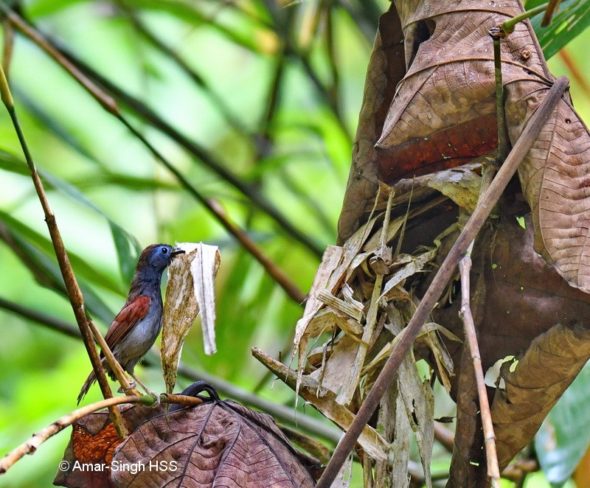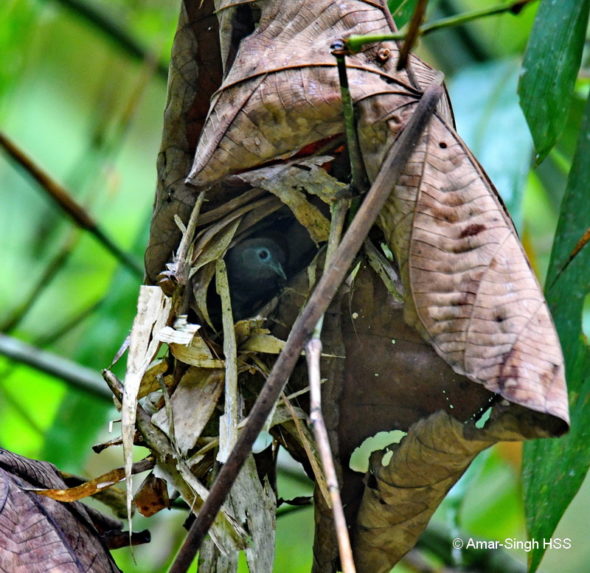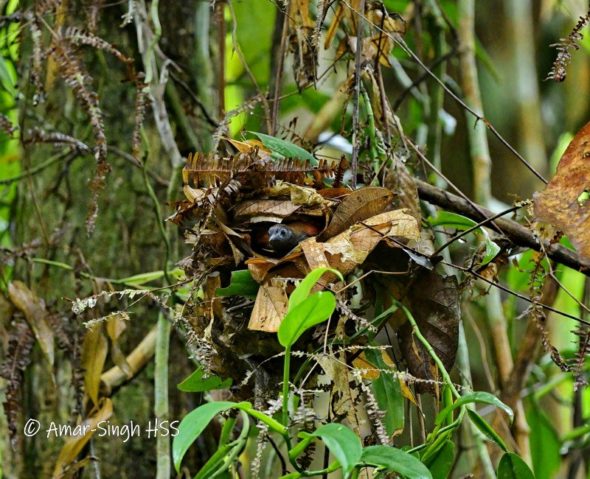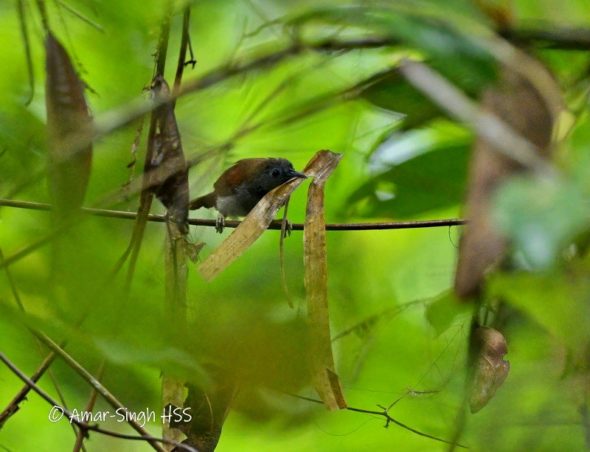This short note is to summarise observations of the Chestnut-winged Babbler (Cyanoderma erythropterum) nesting. Understanding regarding the breeding biology of this babbler is limited.
Wells (2007) offers the most detailed account and describes nests as “sited in a tangle of scrambling ferns, in creepers, between a creeper and pair of sapling stems, in a sapling fork, or lodged in the frond-axil of a rattan, 0.3-8m up, mainly towards the lower end of this range. Nests (easily mistaken for trapped litter) are more or less globular with a dorso-lateral entrance, built of dead leaves and leaf skeletons, often large, including palm- or bamboo leaflets, and lined loosely with fine stems and fibre.” Wells (2007) also reports that although most records of nest-building involved just a pair of birds, in two instances a group of 3–5 individuals participated.
Sheldon, Moyle, and Kennard (2001) report two nests in Sabah and state “nest building was observed twice …. once in two small, adjacent trees about 2 m from the ground in primary forest (Oct 1981) …. and again 4 m up in a Macaranga tree (June 1982) ….. more than two birds were involved in nest building and the nest was not completed”; one “nest was comprised of lacy dead leaves woven with leaf stems and caulked with moss. It was domed, 18 cm high, with a side entrance”.
There are two other nest reports; one by myself in April 2017 at Perak (see references) and another by Laurence Eu and Alan OwYong in May 2018 at Singapore (see references). The Singapore report describes nest building adjacent to a forest track that was then abandoned and a second nest then constructed about 2 metres from the walking track. Alan OwYong (2018) describes the second nest as “about 20 cm wide, made out of a cluster of dry leaves and twigs, attached to an intertwined mass of leaves and thin branches; the entrance is just a small hole by the front side of the nest; the nest was at mid storey”. This second nest was also abandoned.
To date I have observed three nests at the Kledang Saiong Forest Reserve, Ipoh, Perak, Malaysia, all spotted during the construction phase. The nest construction was seen in April 2017, October 2021 and July 2022. The first nest (April 2017, see Image 1 and 2) was built about 2.5 meters above the ground in a bamboo thicket, immediately adjacent to a trail in primary jungle. The birds were using a large dead Macaranga gigantea (Giant Macaranga) leaf that had fallen and lodged on the bamboo, as the ‘base’ for the nest.


The second nest (October 2021, see Image 3) was also close to a trail in primary jungle (2 meters) and located in dense undergrowth on a slope leading to a stream, possibly 0.3-0.4 metres above the ground (not easy to estimate due to density of vegetation and slope of terrain). This second nest was not possible to approach.

The third nest (July 2022, see Image 4, 5, and 6) was approximately 3.5 meters above the forest floor and located in a tangle of creepers in front of a large tree; again it was near a jungle path (5 meters in).



All three nests could easily be confused for some leaf litter that is collected or trapped in the vegetation. They are globular in shape with a front entrance. Nesting material used in all three nests was dried leaves, especially dead bamboo leaves. Leaf skeletons/spines of leaves and fragments of leaves were also used. Nesting material was often collected some distance from the nest site. No calls were made when near the nest. In all three nesting observations I only saw one pair, and both were actively involved in nest building.
On all three occasions, the birds seemed comfortable with me watching from about 5-6 meters distance and continued with nest building activities. However, I am aware that Chestnut-winged Babblers abandon nesting sites very easily and kept my observations brief (15 min first nest, 5 min subsequent two nests). However, in the first nest observation, as expected due to proximity to the trail and fragile siting of the nest, it was abandoned when visited a week later. The second nest was successful but very limited follow up observations were possible (due to terrain difficulties in watching the nest) – no data on food for young or incubation and fledging periods. This third nest appears to be just completed and I hope it offers an opportunity to watch breeding activities.
References:
- Wells, D.R. (2007). The birds of the Thai-Malay Peninsula: Vol. 2 (Passerines). Christopher Helm, London.
- Sheldon, F. H., R. G. Moyle, and J. Kennard (2001). Ornithology of Sabah: History, Gazetteer, Annotated Checklist, and Bibliography. Ornithological Monographs 52. American Ornithologists’ Union, Washington, D.C., USA.
- Amar-Singh HSS (2017). Chestnut-winged Babbler – nest building. Bird Ecology Study Group. <https://besgroup.org/2017/05/22/chestnut-winged-babbler-nest-building/>
- Laurence Eu and Alan OwYong (2018). Nest building by a pair of Chestnut-winged Babblers in Singapore. Singapore Bird Group. <https://singaporebirdgroup.wordpress.com/2019/07/21/nest-building-by-a-pair-of-chestnut-winged-babblers-in-singapore/>
Dato’ Dr Amar-Singh HSS
Ipoh, Perak, Malaysia
Note to readers: If you like this post please tap on the Like button at the left bottom of page.
This short note is to summarise observations of the Chestnut-winged Babbler (Cyanoderma erythropterum) nesting. Understanding regarding the breeding biology of this babbler is limited.
Wells (2007) offers the most detailed account and describes nests as “sited in a tangle of scrambling ferns, in creepers, between a creeper and pair of sapling stems, in a sapling fork, or lodged in the frond-axil of a rattan, 0.3-8m up, mainly towards the lower end of this range. Nests (easily mistaken for trapped litter) are more or less globular with a dorso-lateral entrance, built of dead leaves and leaf skeletons, often large, including palm- or bamboo leaflets, and lined loosely with fine stems and fibre.” Wells (2007) also reports that although most records of nest-building involved just a pair of birds, in two instances a group of 3–5 individuals participated.
Sheldon, Moyle, and Kennard (2001) report two nests in Sabah and state “nest building was observed twice …. once in two small, adjacent trees about 2 m from the ground in primary forest (Oct 1981) …. and again 4 m up in a Macaranga tree (June 1982) ….. more than two birds were involved in nest building and the nest was not completed”; one “nest was comprised of lacy dead leaves woven with leaf stems and caulked with moss. It
was domed, 18 cm high, with a side entrance”.
There are two other nest reports; one by myself in April 2017 at Perak (see references) and another by Laurence Eu and Alan OwYong in May 2018 at Singapore (see references). The Singapore report describes nest building adjacent to a forest track that was then abandoned and a second nest then constructed about 2 metres from the walking track. Alan OwYong (2018) describes the second nest as “about 20 cm wide, made out of a cluster of dry leaves and twigs, attached to an intertwined mass of leaves and thin branches; the entrance is just a small hole by the front side of the nest; the nest was at mid storey”. This second nest was also abandoned.
To date I have observed three nests at the Kledang Saiong Forest Reserve, Ipoh, Perak, Malaysia, all spotted during the construction phase. The nest construction was seen in April 2017, October 2021 and July 2022. The first nest (April 2017, see Image 1 and 2) was built about 2.5 meters above the ground in a bamboo thicket, immediately adjacent to a trail in primary jungle. The birds were using a large dead Macaranga gigantea (Giant Macaranga) leaf that had fallen and lodged on the bamboo, as the ‘base’ for the nest. The second nest (October 2021, see Image 3) was also close to a trail in primary jungle (2 meters) and located in dense undergrowth on a slope leading to a stream, possibly 0.3-0.4 metres above the ground (not easy to estimate due to density of vegetation and slope of terrain). This second nest was not possible to approach. The third nest (July 2022, see Image 4, 5, and 6) was approximately 3.5 meters above the forest floor and located in a tangle of creepers in front of a large tree; again it was near a jungle path (5 meters in).
All three nests could easily be confused for some leaf litter that is collected or trapped in the vegetation. They are globular in shape with a front entrance. Nesting material used in all three nests was dried leaves, especially dead bamboo leaves. Leaf skeletons/spines of leaves and fragments of leaves were also used. Nesting material was often collected some distance from the nest site. No calls were made when near the nest. In all three nesting observations I only saw one pair, and both were actively involved in nest building.
On all three occasions, the birds seemed comfortable with me watching from about 5-6 meters distance and continued with nest building activities. However, I am aware that Chestnut-winged Babblers abandon nesting sites very easily and kept my observations brief (15 min first nest, 5 min subsequent two nests). However, in the first nest observation, as expected due to proximity to the trail and fragile siting of the nest, it was abandoned when visited a week later. The second nest was successful but very limited follow up observations were possible (due to terrain difficulties in watching the nest) – no data on food for young or incubation and fledging periods. This third nest appears to be just completed and I hope it offers an opportunity to watch breeding activities.
References:
- Wells, D.R. (2007). The birds of the Thai-Malay Peninsula: Vol. 2 (Passerines). Christopher Helm, London.
- Sheldon, F. H., R. G. Moyle, and J. Kennard (2001). Ornithology of Sabah: History, Gazetteer, Annotated Checklist, and Bibliography. Ornithological Monographs 52. American Ornithologists’ Union, Washington, D.C., USA.
- Amar-Singh HSS (2017). Chestnut-winged Babbler – nest building. Bird Ecology Study Group. <https://besgroup.org/2017/05/22/chestnut-winged-babbler-nest-building/>
- Laurence Eu and Alan OwYong (2018). Nest building by a pair of Chestnut-winged Babblers in Singapore. Singapore Bird Group. <https://singaporebirdgroup.wordpress.com/2019/07/21/nest-building-by-a-pair-of-chestnut-winged-babblers-in-singapore/>
Dato’ Dr Amar-Singh HSS
Ipoh, Perak, Malaysia








